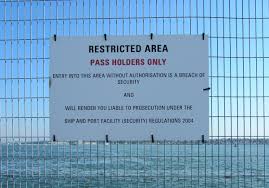Abstract
Each ship must develop a unique plan to protect against security threats. The plan must be approved by the ship’s flag state. Port facilities must also develop a security plan to protect port infrastructure. The plan outlines the responsibilities of port facility personnel and how to respond to potential security breaches. The ISPS Code introduces a three-tiered system of security levels: Level 1: Normal security measures, Level 2: Additional security measures due to an elevated threat level, and Level 3: The highest level of security measures is activated in response to a specific threat or a known risk. Each ship and port facility must appoint a Ship Security Officer (SSO) to maintain the security plan and coordinate actions with relevant authorities. Regular training and drills are mandated for both ship and port personnel to ensure personnel are well-prepared for potential security incidents. The code sets guidelines for information sharing and cooperation between all parties to enhance maritime security. The ISPS Code has significantly improved supply chain security, particularly in the global maritime industry. It reduces the risk of terrorist attacks and piracy, enhancing the security of ports that transport goods across international borders. It encourages risk mitigation and threat assessment, enhancing the security of cargo and fostering international cooperation. It improves monitoring and surveillance, requiring port facilities to implement surveillance systems and ships to be equipped with tracking systems. It requires both ships and port facilities to have contingency plans in place in the event of a security breach or a threat. It provides guidelines for the protection of critical infrastructure against physical attacks or other types of sabotage. The ISPS Code instills confidence in global trade and by ensuring consistent security maintenance using International ship and Port Facility Security Code.
Keywords: International ship and Port Facility Security Code
Introduction
The International Ship and Port Facility Security Code is a key component of global maritime security, designed to enhance the security of ships and port facilities worldwide. It was adopted by the International Maritime Organization (IMO) in December 2002 as part of the United Nations Convention for the Safety of Life at Sea (SOLAS). Its primary goal is to establish an international framework for the detection and prevention of security threats to ships, ports, and the maritime environment. The code came into effect on July 1, 2004, and it remains an essential part of the global effort to ensure the safety and security of the maritime industry.The ISPS Code is divided into two main parts: Part A and Part B. Part A sets out mandatory requirements, while Part B provides non-mandatory guidelines for implementation. Together, these parts outline the roles and responsibilities of ships and port facilities, focusing on the identification, assessment, and management of security risks, and the development of security plans.
Key Components of the International ship and Port Facility Security Code
- Ship Security Plan (SSP): The ISPS Code mandates that each ship must develop a Ship Security Plan. This plan outlines specific measures that a ship will take to protect itself against security threats. The plan is tailored to each ship’s unique operations and characteristics, and it must be approved by the ship’s flag state (the country under whose laws the ship operates).
- Port Facility Security Plan (PFSP): Similarly, port facilities must also develop a security plan. This plan is designed to ensure that the port infrastructure, such as terminals, cranes, and loading areas, is protected against any security risks. The plan outlines the responsibilities of port facility personnel and provides details about how to respond to potential security breaches.
- Security Levels: The ISPS Code introduces a three-tiered system of security levels:
- Level 1: Normal security measures are in place.
- Level 2: Additional security measures are implemented due to an elevated threat level.
- Level 3: The highest level of security measures is activated in response to a specific threat or a known risk.
- Ship and Port Facility Security Officer (SPO and PFSO): The ISPS Code designates specific individuals to oversee security. Each ship is required to have a Ship Security Officer (SSO) responsible for maintaining the security plan and ensuring the implementation of security measures. Similarly, each port facility must appoint a Port Facility Security Officer (PFSO) to manage the security plan and coordinate actions with relevant authorities.
- Training and Drills: To ensure that personnel are well-prepared for any potential security incidents, the ISPS Code mandates regular training and drills for both ship and port personnel. These exercises help identify weaknesses in security procedures and allow for improvements to be made in a controlled environment.
- Communication and Cooperation: Effective communication between ships, port facilities, and relevant authorities is crucial under the ISPS Code. The code sets guidelines for information sharing and cooperation between all parties to enhance maritime security.
- Example of Beypore port:The ISPS Code is significant for the Beypore port because it allows the port to receive international vessels, enabling foreign ships to dock directly and facilitating immigration clearance, essentially elevating the port to an international standard by implementing enhanced security measures like X-ray scanning, metal detectors, and advanced communication systems, which were necessary to meet the ISPS Code requirements.
How the International ship and Port Facility Security Code Enhances Supply Chain Security
The ISPS Code has had a profound impact on supply chain security, particularly in the global maritime industry, which is central to international trade. The code’s mandatory provisions have been implemented across shipping lines, ports, and related logistics systems, ensuring that they operate with a heightened awareness of potential security threats.
- Prevention of Terrorist Attacks and Piracy: One of the primary benefits of the ISPS Code is its ability to reduce the risk of terrorist attacks and piracy, which have the potential to disrupt global trade. The ISPS Code mandates the installation of effective security measures on both ships and port facilities, making it more difficult for terrorists or criminals to target maritime assets. By implementing thorough security assessments, monitoring, and response strategies, the ISPS Code helps deter unlawful activities, including hijacking, smuggling, and sabotage.
A concrete example is the heightened security in ports that transport goods across international borders. The code provides a clear framework for identifying and addressing threats, which lowers the chances of successful attacks that could damage infrastructure, result in the loss of goods, or cause delays in supply chains.
- Risk Mitigation and Threat Assessment: The ISPS Code encourages ports and ships to engage in a thorough risk assessment process. By identifying potential security threats in advance, companies can implement preventive measures, reducing the likelihood of disruptions. This proactive approach helps to mitigate the risks associated with maritime threats that could otherwise affect the global flow of goods.
Risk assessment also plays a critical role in evaluating the security of cargo. For instance, container security measures have been enhanced to ensure that no unauthorized items are introduced into the global supply chain. The use of technologies such as tracking systems, sealing devices, and X-ray scanning are part of this effort, contributing to safer and more secure shipping operations.
- Enhanced Compliance and International Cooperation: Global trade relies on cooperation between various countries and their authorities. The ISPS Code fosters this international collaboration by setting consistent security standards that are applicable worldwide. Port facilities and ships in all countries are expected to comply with the same security standards, ensuring a unified approach to maritime safety.
By enforcing these standards across borders, the ISPS Code helps reduce vulnerabilities in the international supply chain. Importers, exporters, and logistics providers can be more confident that the goods they are transporting are secure, regardless of where they are being shipped from or to. This consistency fosters smoother trade operations and builds trust among trade partners.
- Improved Monitoring and Surveillance: One of the major advancements introduced by the ISPS Code is the increased use of monitoring systems to detect security risks in real time. Port facilities are required to implement surveillance systems such as CCTV cameras, access control systems, and other technologies to monitor activities and identify potential threats before they can materialize into actual risks.
For ships, the code requires them to be equipped with tracking systems that monitor their location and any unusual activity. This helps authorities to identify ships that may be in distress, deviating from their intended routes, or engaging in suspicious behavior. The increased level of monitoring provides greater oversight and helps authorities take swift action when necessary.
- Contingency Planning and Response: In the event of a security breach or a threat, the ISPS Code requires both ships and port facilities to have contingency plans in place. These plans outline the specific actions that must be taken to address security issues, such as an attempted hijacking or a potential bomb threat. The preparedness outlined in these plans ensures a swift and effective response, which can minimize the damage caused by such incidents and reduce delays in supply chains.
The code also encourages coordination between shipping companies, port authorities, and government agencies. This collective response mechanism ensures that threats are addressed in a timely manner, preventing the disruption of operations and ensuring the continuity of the supply chain.
- Protection of Critical Infrastructure: The security of maritime infrastructure, such as ports and shipping terminals, is critical to maintaining the smooth operation of the global supply chain. The ISPS Code provides guidelines for the protection of critical infrastructure against physical attacks or other types of sabotage. It establishes clear protocols for securing access to ports, terminals, and warehouses, ensuring that these assets remain operational and protected.
By safeguarding these key facilities, the ISPS Code helps prevent delays or disruptions that could otherwise occur if port infrastructure were targeted. As a result, the code ensures that the global supply chain operates more efficiently and securely, reducing the chances of delays in transportation.
- Confidence in Global Trade: The ISPS Code instills confidence among stakeholders in the global supply chain by ensuring that security is consistently maintained. With the implementation of strict security measures and risk assessments, shipping companies, ports, and logistics providers can be more certain that their operations are secure. This confidence fosters greater participation in international trade and helps maintain the smooth flow of goods across borders.
Conclusion
In conclusion, the International ship and Port Facility Security Code plays a pivotal role in enhancing the security of the global supply chain by addressing maritime security threats and ensuring that appropriate measures are in place to prevent disruptions. By requiring ships and port facilities to adhere to standardized security protocols, the ISPS Code helps mitigate the risks associated with terrorism, piracy, and other security breaches. Furthermore, the code promotes international cooperation, enhances monitoring and surveillance, and ensures that contingency plans are in place for a swift response to security threats. Through these mechanisms, the ISPS Code not only protects the maritime industry but also contributes to the overall efficiency and reliability of global trade, fostering a safer and more secure supply chain worldwide.
Further Reading:
1.https://en.wikipedia.org/wiki/International_Ship_and_Port_Facility_Security_Code
2. “The ISPS Code For Ships-An Essential Quick Guide”. www.marineinsight.com. Retrieved 13 May2020.
3. https://youtu.be/W0PEfoQNt6g?si=3Y6OfAbzhOSIVpvX
4. https://rumble.com/v6q5i1y-understanding-the-isps-code-is-crucial-for-maritime-security.html





